2020-23 PREHISTORIC LIFE by Emporium Hamburg
Never let it be said that we don’t love a good dinosaur coin here, and that goes double for a keenly priced bullion coin. One of Emporium Hamburg’s ranges, alongside the hugely popular Somali Elephant and others, Prehistoric Life debuted in 2020 with, of course, a coin depicting that biggest of dino stars, Tyrannosaurus Rex. The coin looked good, although like many bullion series, early renders were a little crude. Having seen the coin in hand, it’s actually a very nice piece. The design, on this and subsequent issues, is a little more complex than you’d expect of a bullion coin, with the animal placed as part of an environmental scene rather than in close-up or isolation. It needs a little more care to pull off, but EH seem to have managed it well, with enough detail to keep things looking crisp.
The next coin, the weakest in my view, was the Plesiosaur, followed by a terrific sauropod, and then on to a fine mix of reptiles, fish, and mammals, across various habitats and time periods. It’s actually an excellent mix of different subjects. At the time of updating, all twelve issues are out, and we got the cryptid response from EH that it is finished ‘for now’. We really hope they launch a sequel soon.
There are now three versions of each issue on sale. The most popular is obviously the one ounce 0.9999 silver bullion coin, which has a relatively tiny mintage of just 10,000 pieces. The producer now also offers a coloured version of that coin, which seems to retail for around €10 more. We’ve yet to see one in hand, so can’t comment on the all important quality of application, but at least it’s an official piece and not an aftermarket job. Last, but certainly not least, is a 0.5 gram minigold version. These are tiny, but cheap for gold, and the format is increasingly popular. We love them.
Tyrannosaurus lived throughout what is now western North America, on what was then an island continent known as Laramidia. Fossils are found in a variety of rock formations dating to the Maastrichtian age of the upper Cretaceous Period, 68 to 66 million years ago. It was the last known member of the tyrannosaurids, and among the last non-avian dinosaurs to exist before the Cretaceous–Paleogene extinction event.
Tyrannosaurus was a bipedal carnivore with a massive skull balanced by a long, heavy tail. Relative to its large and powerful hind limbs, Tyrannosaurus fore limbs were short but unusually powerful for their size and had two clawed digits. The most complete specimen measures up to 12.3 m in length, up to 4 meters tall at the hips, and up to 6.8 metric tons in weight. Although other theropods rivaled or exceeded Tyrannosaurus rex in size, it is still among the largest known land predators and is estimated to have exerted the largest bite force among all terrestrial animals.
By far the largest carnivore in its environment, Tyrannosaurus rex was likely an apex predator, preying upon hadrosaurs, ceratopsians, and possibly sauropods. Some experts, however, have suggested the dinosaur was primarily a scavenger. It is accepted now that Tyrannosaurus rex acted as a predator, and scavenged as modern mammalian and avian predators do. (Source: Wikipedia)
The first complete skeleton of Plesiosaurus was discovered by early palaeontologist and fossil hunter Mary Anning in Early Jurassic-age rocks in December 1823. Plesiosaurus was one of the first of the “antediluvian reptiles” to be discovered and excited great interest in Victorian England. It was so-named (“near lizard”) by William Conybeare and Henry De la Beche, to indicate that it was more like a normal reptile than Ichthyosaurus, which had been found in the same rock strata just a few years earlier.
It is distinguishable by its small head, long and slender neck, broad turtle-like body, a short tail, and two pairs of large, elongated paddles. It lends its name to the order Plesiosauria, of which it is an early, but fairly typical, member. Furthermore, it contains only one species, the type, Plesiosaurus dolichodeirus. Plesiosaurus was a moderately sized plesiosaur that grew to a length of about 3.5 metres.
Plesiosaurus fed mainly on clams and snails, and are thought to have eaten belemnites, fish and other prey as well. Its U-shaped jaw and sharp teeth would have been like a fish trap. It propelled itself by the paddles, the tail being too short to be of much use. Plesiosaurus gave live birth to live young in the water like sea snakes. The young might have lived in estuaries before moving out into the open ocean.(Source: Wikipedia)
Mamenchisaurus is a genus of sauropod dinosaur known for their remarkably long necks, which made up nearly half the total body length. Numerous species have been assigned to the genus; however, many of these might be questionable. Fossils have been found in the Sichuan Basin and Yunnan Province in China.
Most species were medium to large size sauropods 15 to 26 meters in length. Two as yet undescribed cervical vertebrae, which might belong to M. sinocanadorum, suggest one of the largest dinosaurs known; estimated at 35 metres in length and possibly weighed between 60 and 80 tonnes.
Mamenchisaurus is sometimes referred to as a ‘wastebasket taxon’, with researchers questioning the number of species and fragmentary remains assigned to the genus. The genus is poorly defined with an increasingly confused taxonomy, which makes understanding phylogenic relationships difficult. (Source: Wikipedia)
The woolly mammoth lived during the Pleistocene until its extinction in the early Holocene epoch. It was one of the last in a line of mammoth species, and its closest extant relative is the Asian elephant. The appearance and behaviour of this species are among the best studied of any prehistoric animal because of the discovery of frozen carcasses in Siberia and Alaska, as well as skeletons, teeth, stomach contents, dung, and depiction from life in prehistoric cave paintings. The mammoth was identified as an extinct species of elephant by Georges Cuvier in 1796.
The woolly mammoth was roughly the same size as modern African elephants. Males reached shoulder heights between 2.7 and 3.4 m and weighed up to 6 metric tons. A newborn calf weighed about 90 kg. It was well adapted to the cold environment during the last ice age. It was covered in fur, with an outer covering of long guard hairs and a shorter undercoat, the colour of the coat varying from dark to light.
Its behaviour was similar to that of modern elephants, and it used its tusks and trunk for manipulating objects, fighting, and foraging. The diet of the woolly mammoth was mainly grasses and sedges. Individuals could probably reach the age of 60. Its habitat was the mammoth steppe, which stretched across northern Eurasia and North America.(Adapted from Wikipedia)
Named after the Greek for ‘Ancient Feather’, Archaeopteryx was for a long time considered a missing link between birds and dinosaurs and one of the first discovered feathered reptiles that could be classified as a bird.
Others have been found since, but the quality of the fossils discovered in Germany have been quite amazing, so it remains hugely important. Growing to about 0.5 m in length and with broad wings, they probably spent more time gliding than flying like a modern bird.
Indeed, they had much more in common with reptiles of the time, like sharp teeth, a bony tail, and hyperextensible second toes. Just twelve skeletons of the animal have ever been discovered, the last announced in 2014, and they do differ in age and detail. The first specimen, from 1861 and now held by the Natural History Museum in London, is considered the holotype.
Darwin had written his seminal work, On the Origin of Species, just two years before, and Archaeopteryx was an important example that helped cement his theories on evolution.
Quetzalcoatlus is a pterosaur known from the Late Cretaceous period of North America (Maastrichtian stage), it was one of the largest known flying animals of all time. Quetzalcoatlus is a member of the family Azhdarchidae, a family of advanced toothless pterosaurs with unusually long, stiffened necks. Its name comes from the Aztec feathered serpent god, Quetzalcoatl, in Nahuatl.
When named as a new species in 1975, scientists estimated that the largest Quetzalcoatlus fossils came from an individual with a wingspan as large as 15.9 m. More recent estimates based on greater knowledge of azhdarchid proportions place its wingspan at 10–11 m. Remains found in Texas in 1971 indicate that this reptile had a minimum wingspan of about 11 m with a generalised height in a bipedal stance of at least 3 m high at the shoulder. Modern views have it as flightless.
There have been a number of different ideas proposed about the lifestyle of Quetzalcoatlus. Because the area of the fossil site was 400 km removed from the coastline and there were no indications of large rivers or deep lakes nearby at the end of the Cretaceous, Lawson in 1975 rejected a fish-eating lifestyle, instead suggesting that Quetzalcoatlus scavenged on the carcasses of titanosaur sauropods such as Alamosaurus. (Adapted from Wikipedia)
Gigantopithecus is an extinct genus of ape from the Early to Middle Pleistocene of southern China, represented by one species, Gigantopithecus blacki. The first remains of Gigantopithecus, two third molar teeth, were identified in a drugstore by anthropologist Ralph von Koenigswald in 1935, who subsequently described the ape. In 1956, the first mandible and more than 1,000 teeth were found in Liucheng, and numerous more remains have since been found in at least 16 sites.
Gigantopithecus has traditionally been restored as a massive, gorilla-like ape, potentially 200–300 kg when alive, but the paucity of remains make total size estimates highly speculative. The species may have been sexually dimorphic, with males much bigger than females.
Gigantopithecus appears to have been a generalist herbivore of C3 forest plants, with the jaw adapted to grinding, crushing, and cutting through tough, fibrous plants, and the thick enamel functioning to resist foods with abrasive particles such as stems, roots, and tubers with dirt.
It primarily lived in subtropical to tropical forest, and went extinct about 300,000 years ago likely because of the retreat of preferred habitat due to climate change, and potentially archaic human activity. (Source: WIkipedia)
Liopleurodon, meaning ‘smooth-sided teeth’ is an extinct genus of large, carnivorous marine reptile belonging to a clade of short-necked pliosaurid plesiosaurs. The two species of Liopleurodon lived from the Middle to the Late Jurassic Period (c. 166 to 155 MYA). It was the apex predator of the seas that covered Europe. The largest species, L. ferox, is estimated to have grown up to 6.6 metres in length, but could have been larger.
Liopleurodon ferox first came to the public attention in 1999 when it was featured in an episode of the BBC television series Walking with Dinosaurs, which depicted it as an enormous 25 m long and 150 t predator; this was based on very fragmentary remains, and considered to be an exaggeration. Modern estimates have the length at circa 7 m, with exceptional specimens hitting 10 m, and around 3 tonnes.
Four strong paddle-like limbs suggest that Liopleurodon was a powerful swimmer. Its four-flipper mode of propulsion is characteristic of all plesiosaurs. A study involving a swimming robot has demonstrated that although this form of propulsion is not especially efficient, it provides very good acceleration—a desirable trait in an ambush predator. Studies of the skull have shown that it could probably scan the water with its nostrils to ascertain the source of certain smells. (Wikipedia)
Parasaurolophus is a genus of hadrosaurid ornithopod dinosaur that lived in what is now North America and possibly Asia during the Late Cretaceous Period, about 76.5–73 million years ago. It was a herbivore that walked both as a biped and as a quadruped. Remains are known from Alberta (Canada), New Mexico and Utah (United States), and possibly Heilongjiang (China). The genus was first described in 1922 by William Parks from a skull and partial skeleton found in Alberta.
Parasaurolophus was part of a diverse family of Cretaceous dinosaurs known for their range of bizarre head adornments, which were likely used for communication and better hearing. This genus is known for its large, elaborate cranial crest, which at its largest forms a long curved tube projecting upwards and back from the skull. Visual recognition of both species and sex, acoustic resonance, and thermoregulation have been proposed as functional explanations for the crest.
The length of the type specimen is estimated at 9.45 m and its body mass at 2.47 metric tons according to Gregory S. Paul, but other estimates have them larger. (Adapted from: Wikipedia)
Titanoboa is an extinct genus of very large snakes that lived in what is now La Guajira in northeastern Colombia. They could grow up to 12.8 m, perhaps even 14.3 m long and reach a body mass of 730–1,135 kg.
This snake lived during the Middle to Late Paleocene epoch, around 60 to 58 million years ago, following the extinction of all non-avian dinosaurs. Although originally thought to be an apex predator, the discovery of skull bones revealed that it was more than likely specialized in preying on fish.
The only known species is Titanoboa cerrejonensis, the largest snake ever discovered, which supplanted the previous record holder, Gigantophis garstini.
LInitially, Titanoboa was thought to have acted much like a modern anaconda based on its size and the environment it was deposited in, with researchers suggesting that it may have in part fed on the local crocodylomorph fauna.
However, it’s noted that the skull of this snake displays multiple adaptations to a piscivorous diet Such a lifestyle would be supported by the extensive rivers of Paleocene Colombia, as well as the fossil fish (lungfish and osteoglossomorphs) recovered from the formation.(Wikipedia)
Dunkleosteus, a prehistoric fish from the Devonian period, holds a place of fascination and intrigue in the world of paleontology. With its monstrous size and formidable appearance, Dunkleosteus was a true apex predator of the ancient oceans. Growing up to 30 feet in length, it possessed a heavily armored body and an impressive set of razor-sharp jaws.
The most striking feature of Dunkleosteus was its massive bony plates that covered its head and neck, providing exceptional protection. These plates, along with its strong bite, made it a fearsome predator capable of crushing and devouring its prey with ease. It relied on a unique suction-feeding mechanism, allowing it to engulf its victims in a split second.
Despite its enormous size, Dunkleosteus had a relatively small brain, suggesting it may have relied on instinct and sheer power rather than complex cognitive abilities. Its dominance in the Devonian seas lasted for millions of years, until its extinction around 360 million years ago.
Belonging to the family Stegosauridae, this herbivorous creature inhabited what is now North America around 150 million years ago. Its most striking feature, a double row of large, bony plates along its back, is a subject of ongoing scientific debate.
While they were once thought to act as body armour or aid in thermoregulation, more recent theories suggest they might have played a role in communication or were simply displays for attracting mates.
The tail of Stegosaurus, known as the “thagomizer,” is a fearsome weapon consisting of several sharp spikes. It’s believed that this unique adaptation served as a defence mechanism against predators, dissuading even the most determined assailants.
Stegosaurus, despite its imposing appearance, had a relatively small brain. Nevertheless, it represented a successful branch of the dinosaur family tree, adapting to its environment over millions of years.
A typical Congo obverse there’s a border that holds the inscribed issuing country, and the denomination of 20 Francs, although in this case, the coin composition is also inscribed here.
The coat of arms of the Democratic Republic of the Congo is one that has changed quite a few times, with the latest version having its origins in 2006 under the rule of President Joseph Kabila.
It depicts a leopard head, surrounded by an elephant tusk to the left and a spear to the right. Below are the three words which make up the national motto: Justice, Paix, Travail (Justice, Peace, Work in French).
| PREHISTORIC LIFE RANGE | |||
| DENOMINATION | 20 Francs (Congo) | 20 Francs (Congo) | 100 Francs (Congo) |
| COMPOSITION | 0.9999 silver | 0.9999 silver | 0.9999 gold |
| WEIGHT | 31.1 grams | 31.1 grams | 0.5 grams |
| DIMENSIONS | 38.6 mm | 38.6 mm | 11.0 mm |
| FINISH | Bullion | Bullion | Proof |
| MODIFICATIONS | None | Colour | None |
| MINTAGE | 10,000 | 2,000 | 2,000 |
| BOX / C.O.A. | No / No | No / No | No / No |





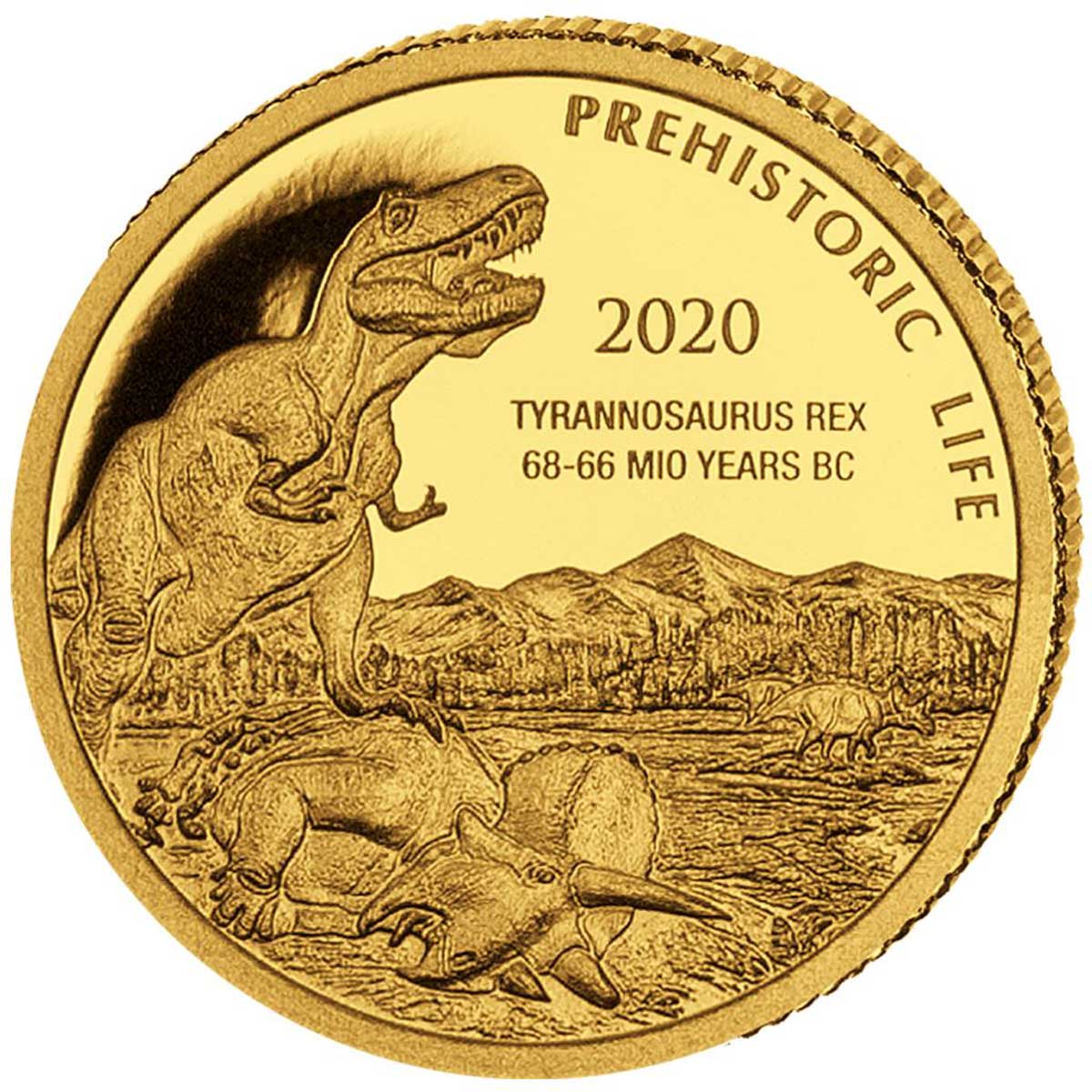




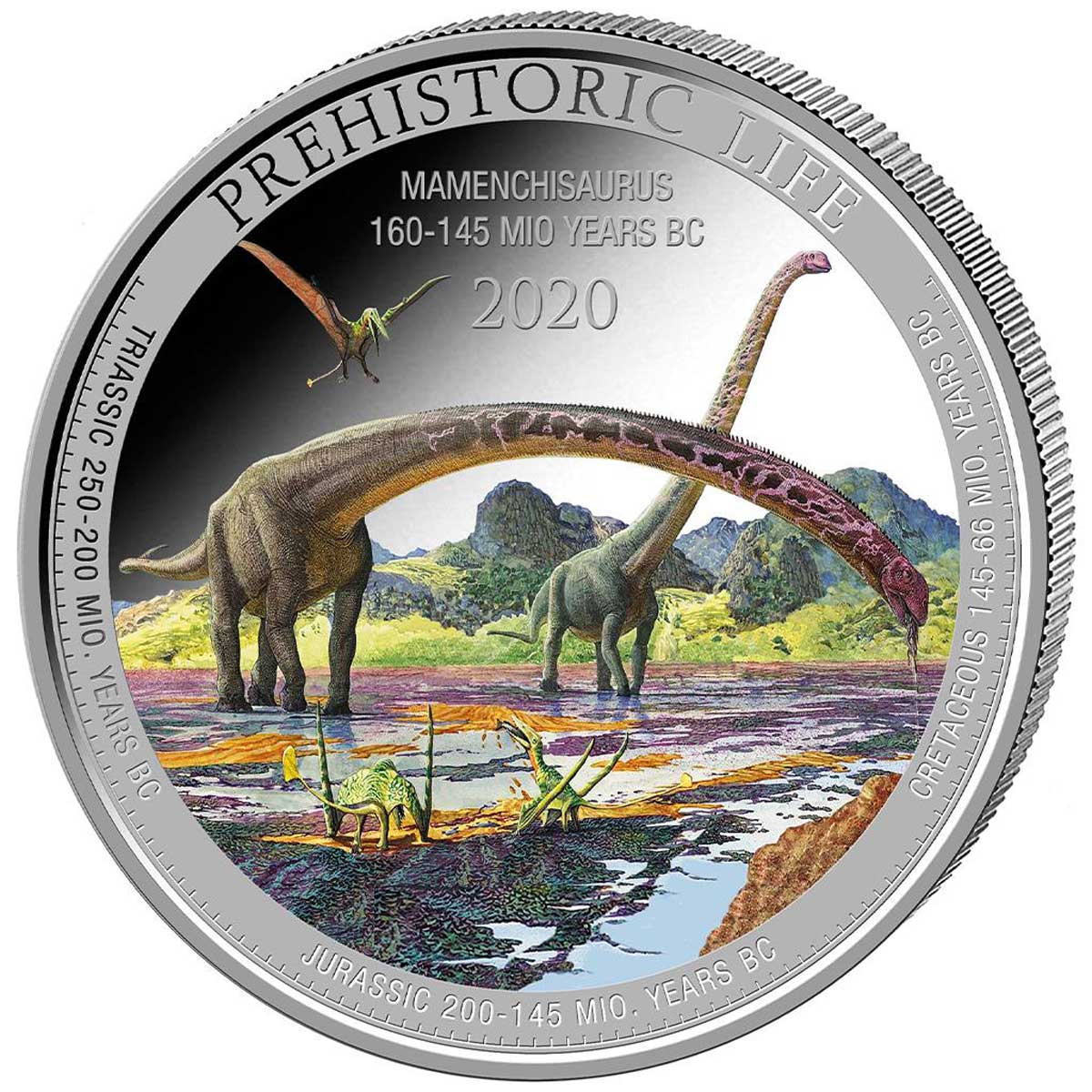
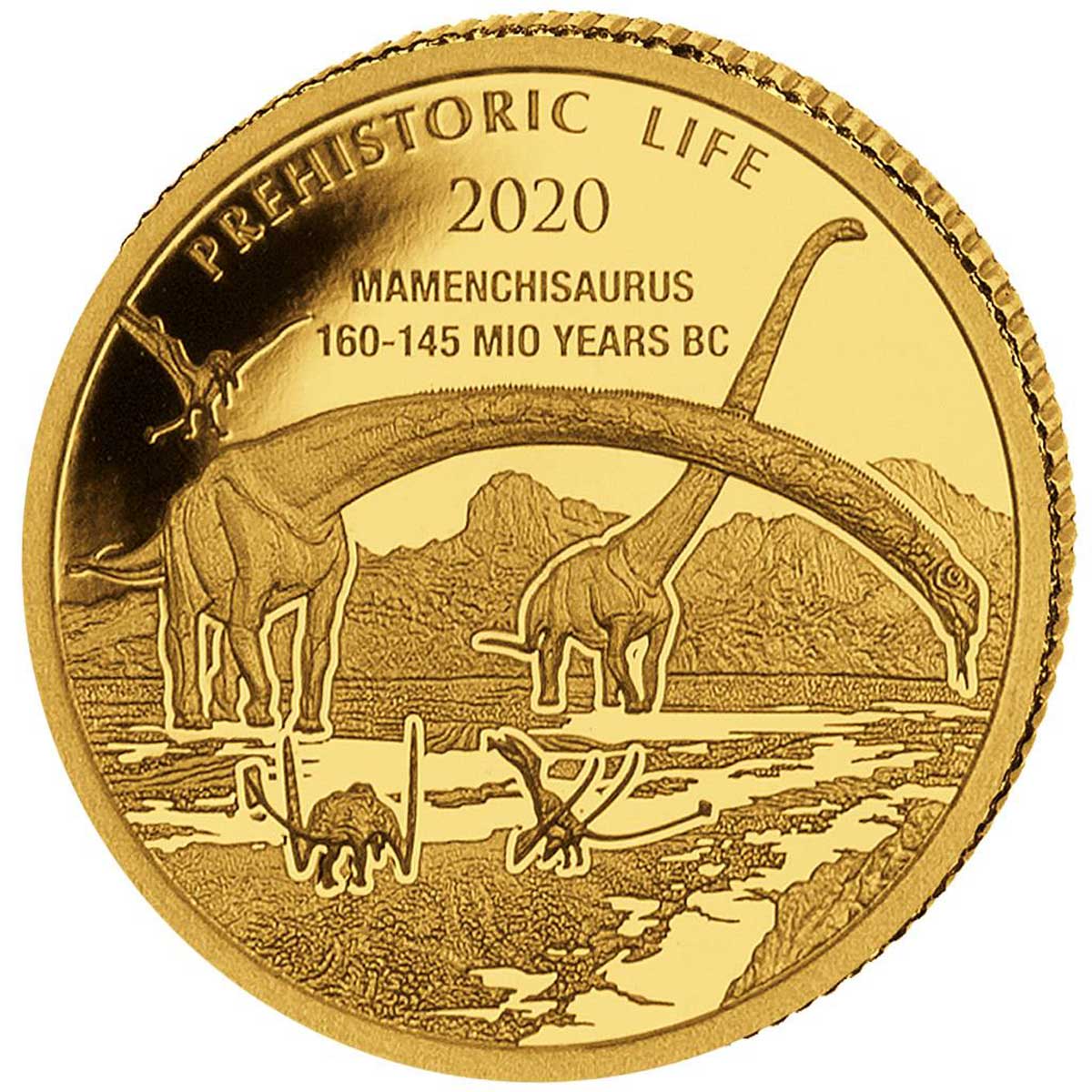
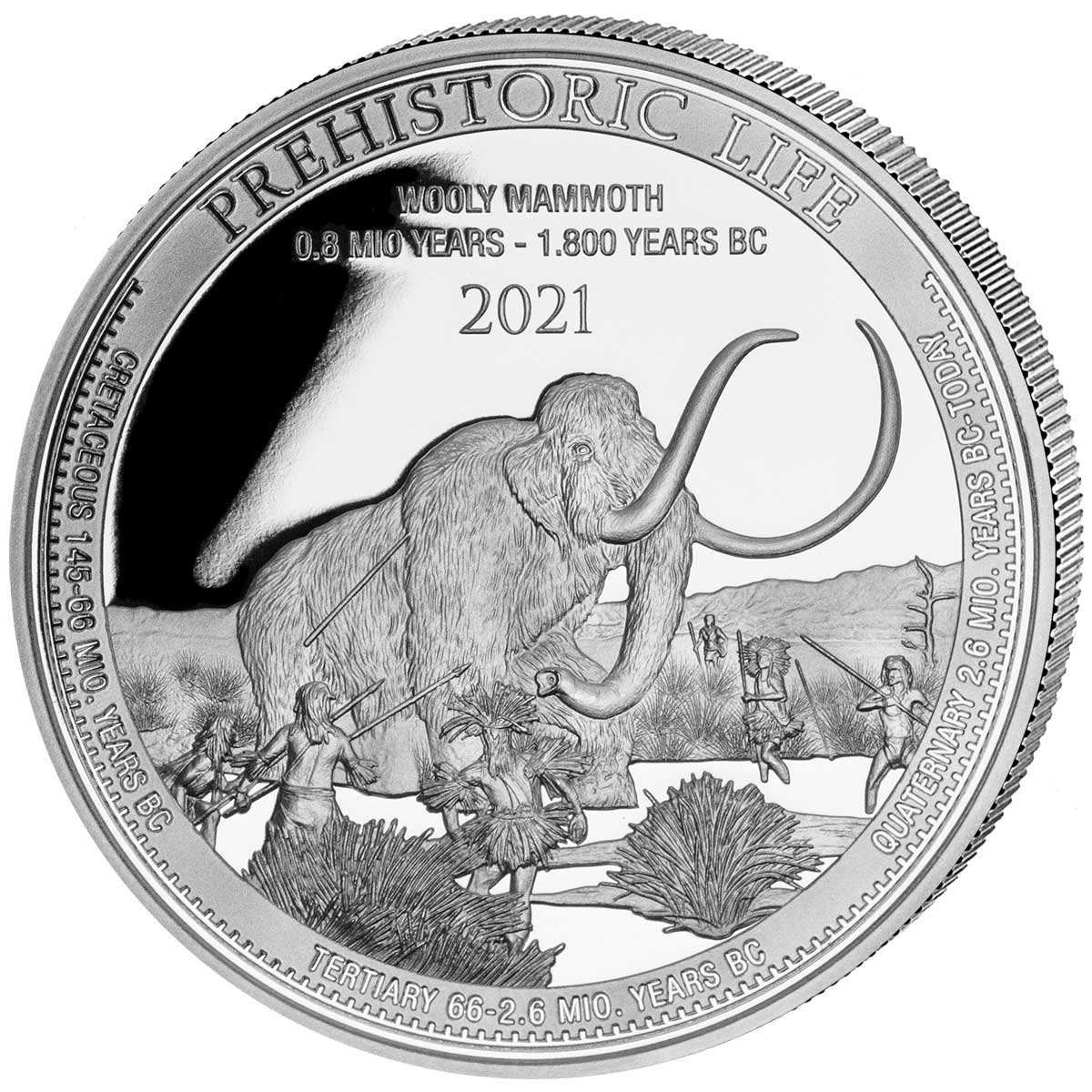

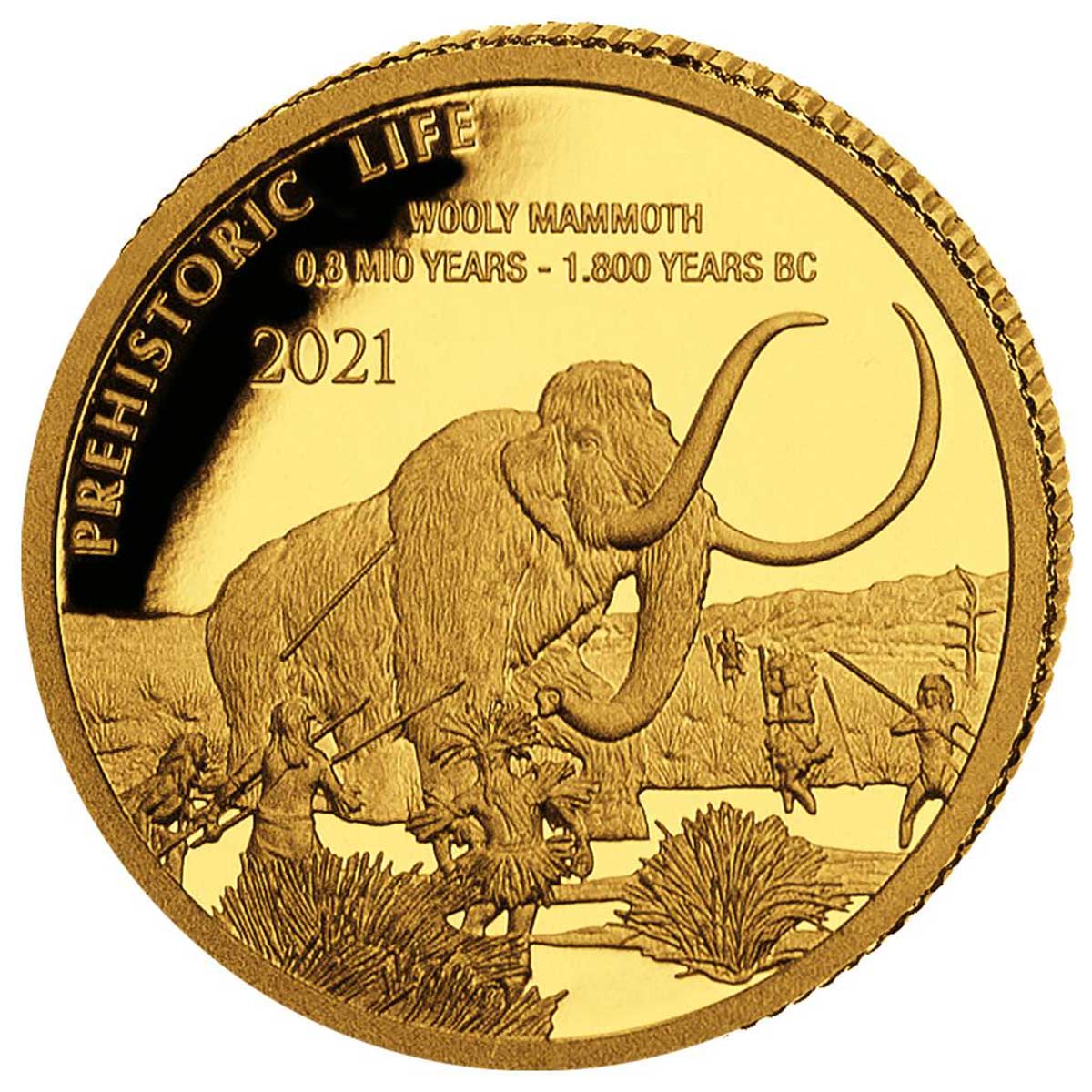
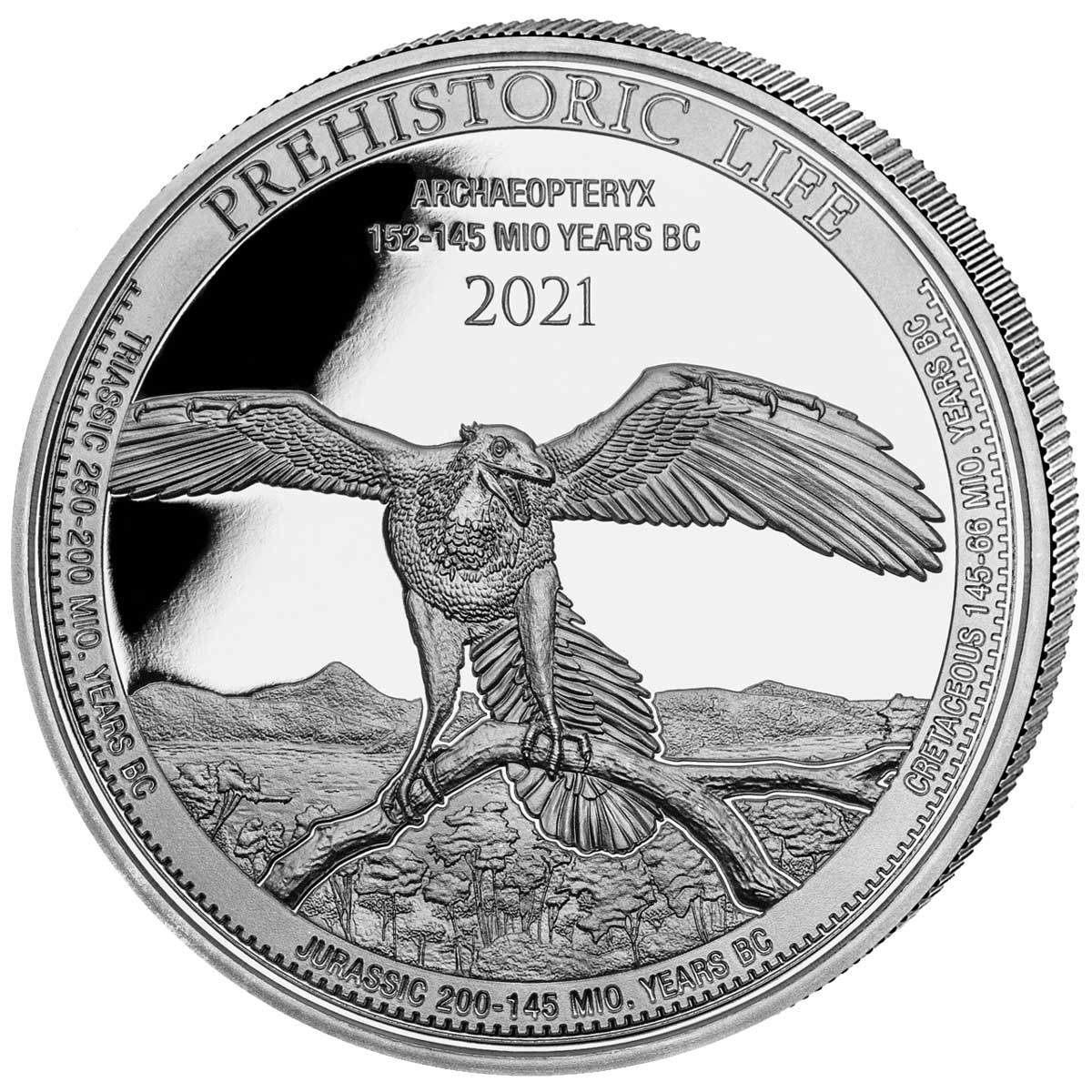
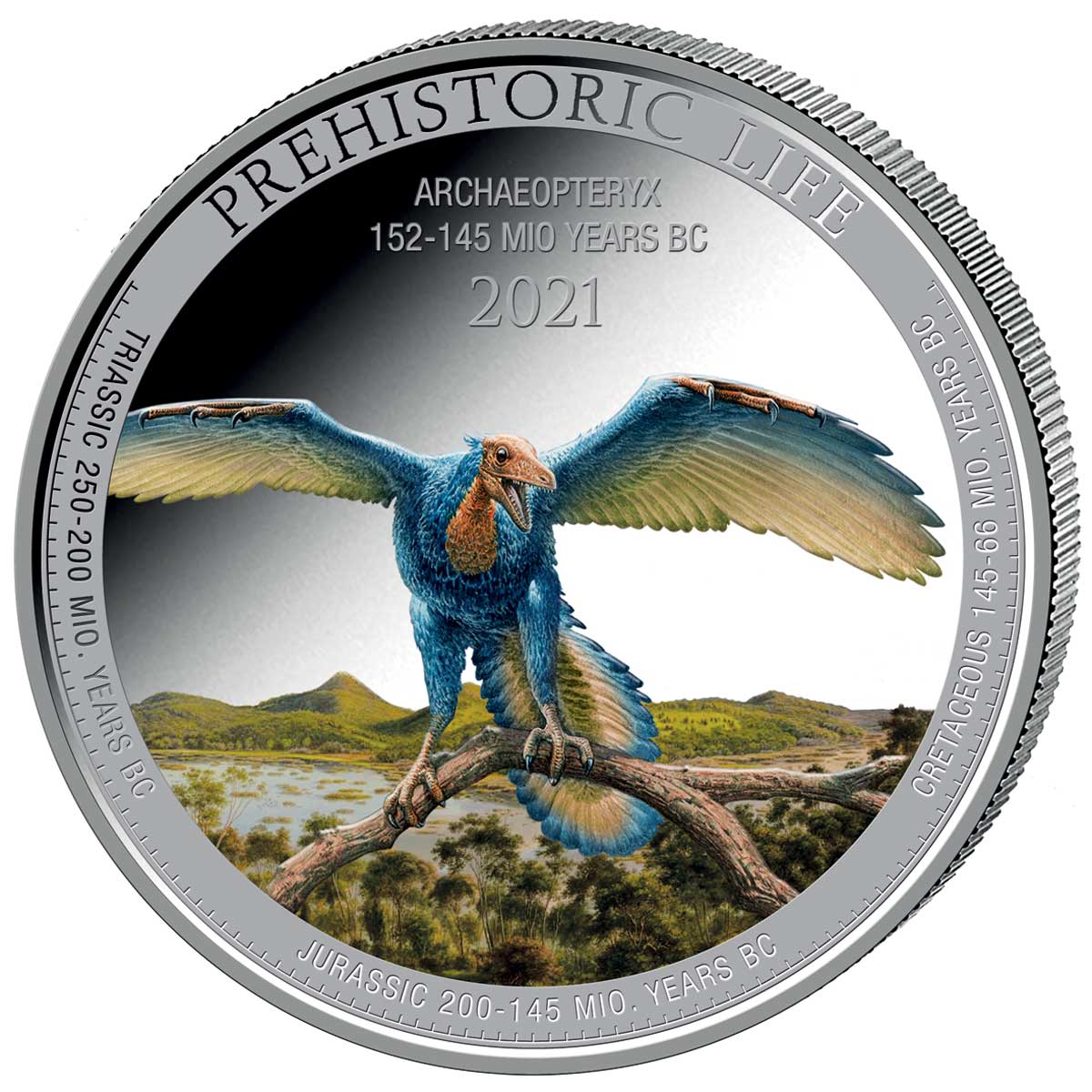
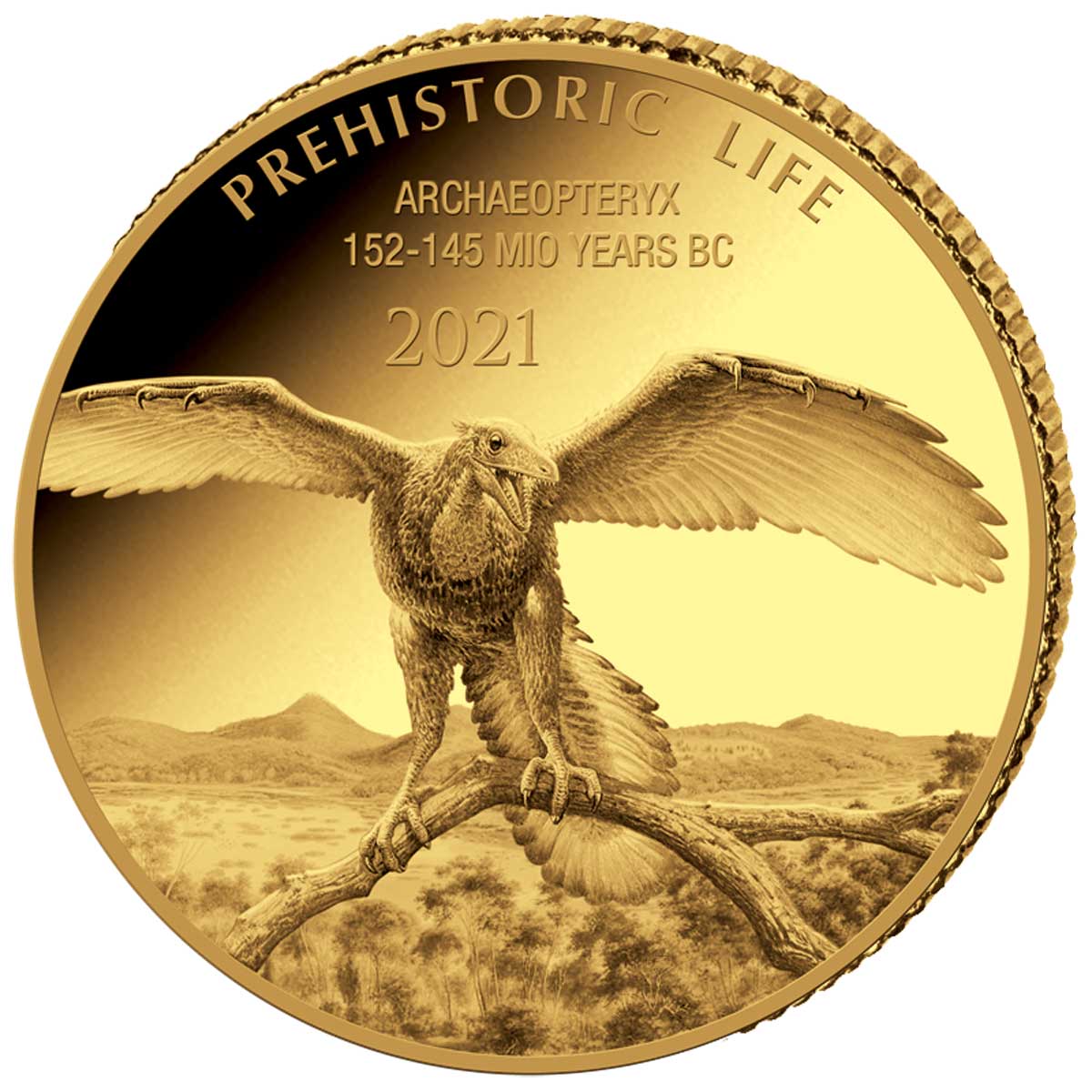
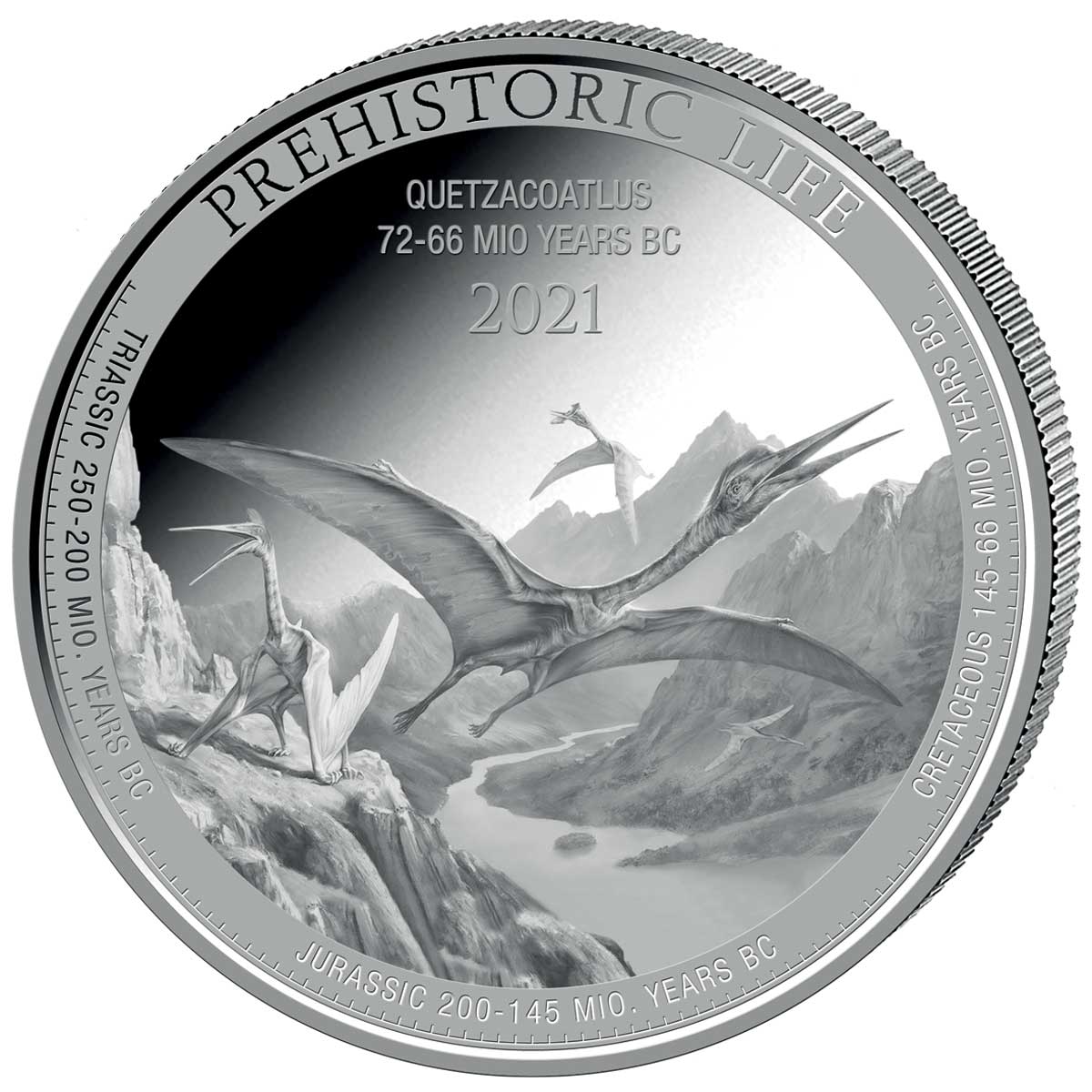

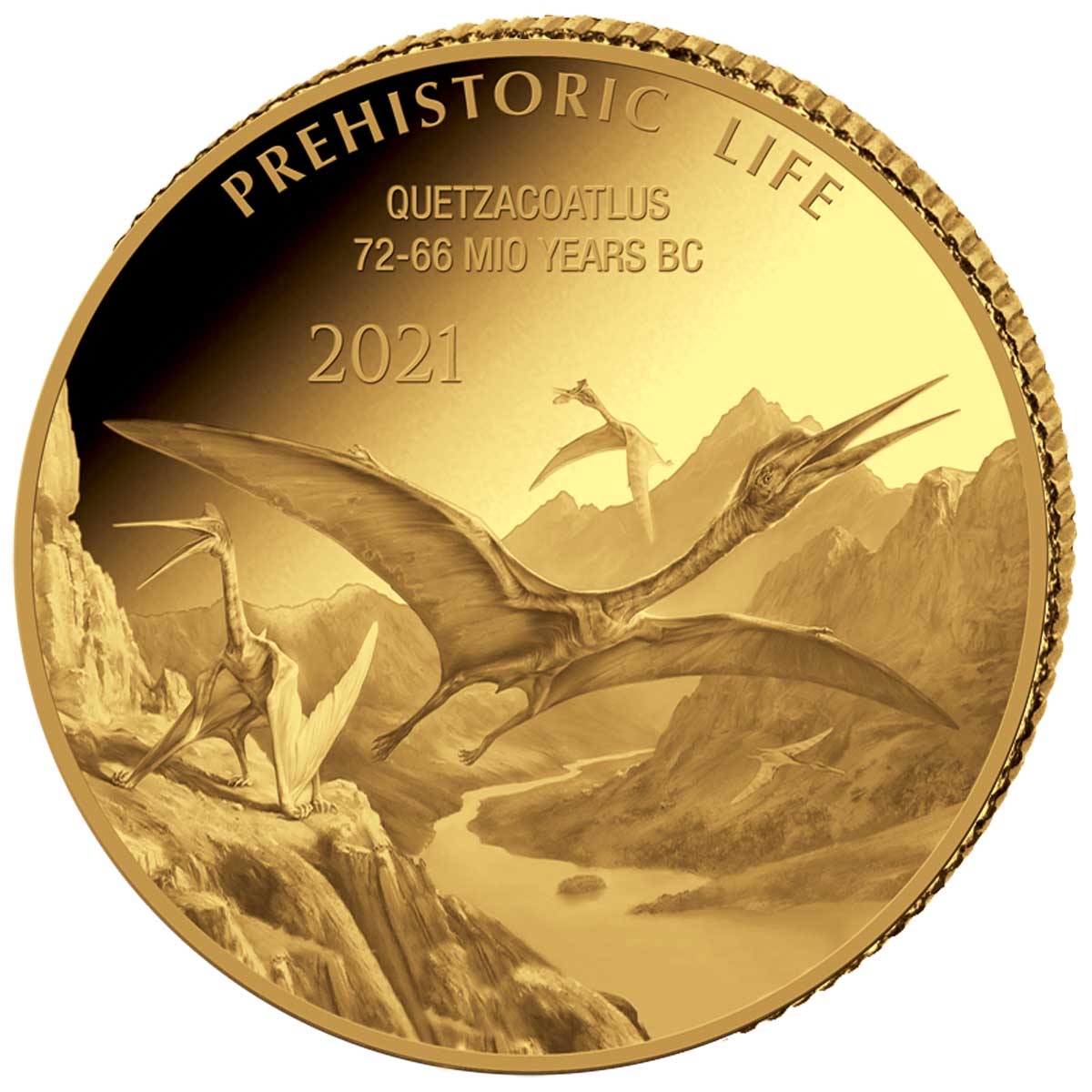

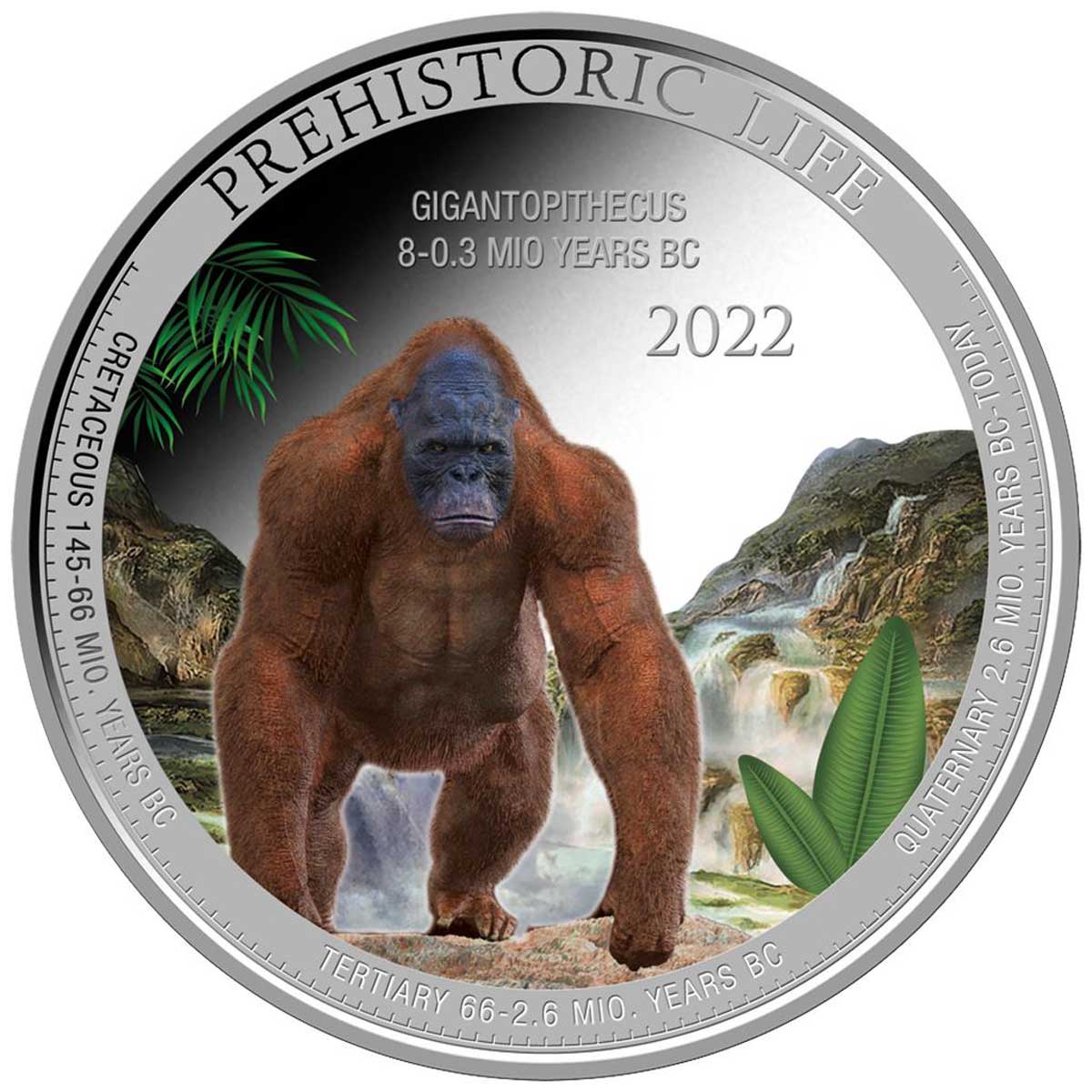



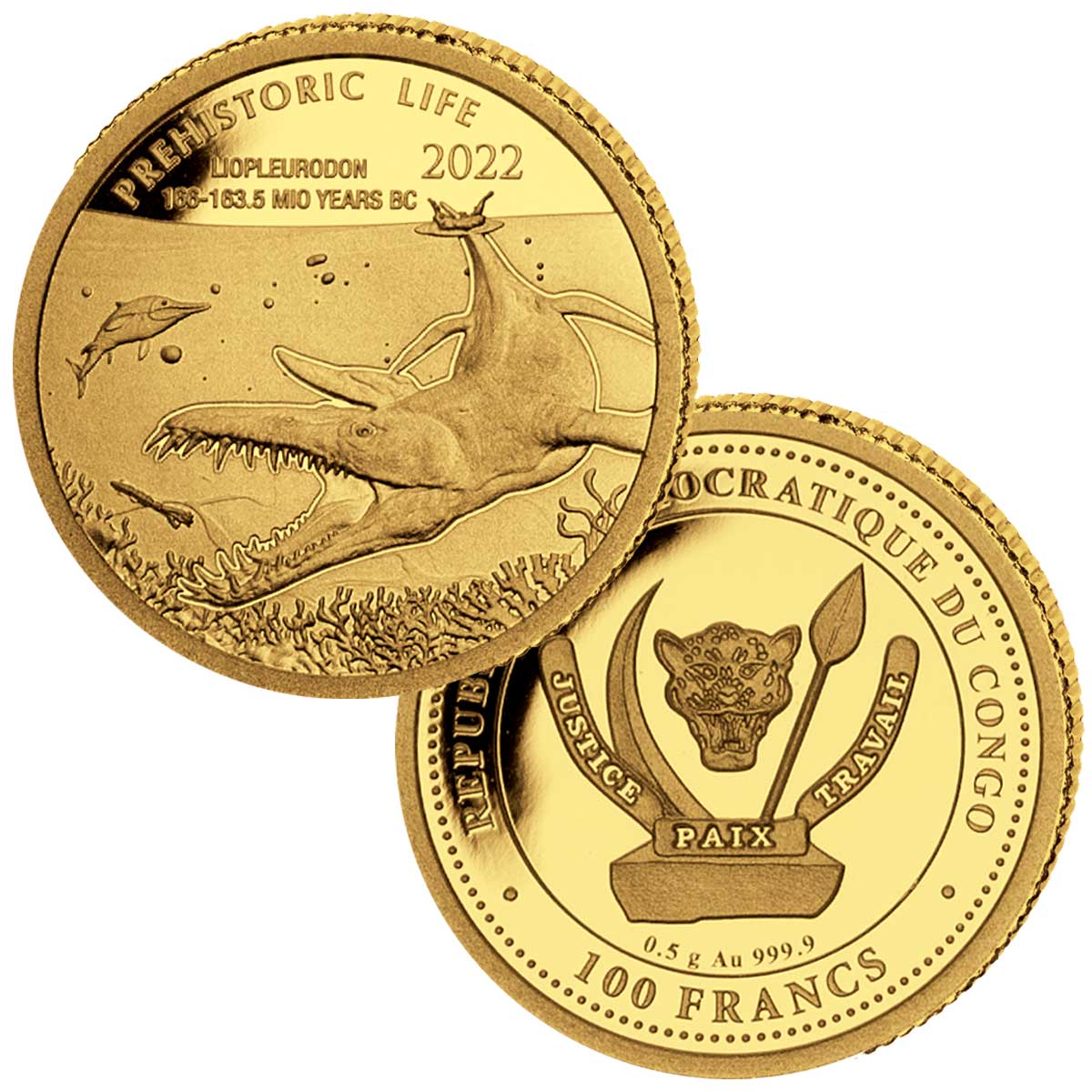

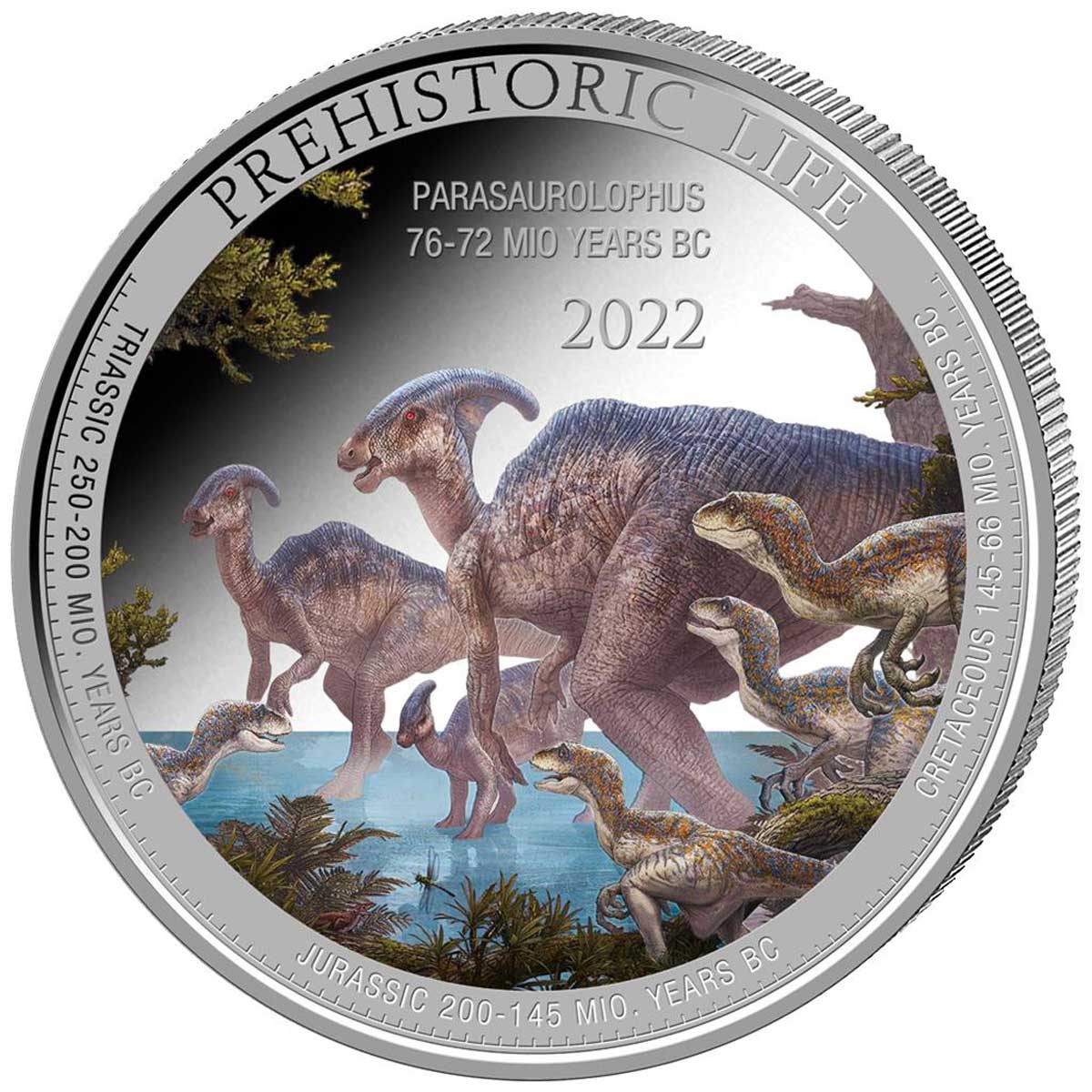

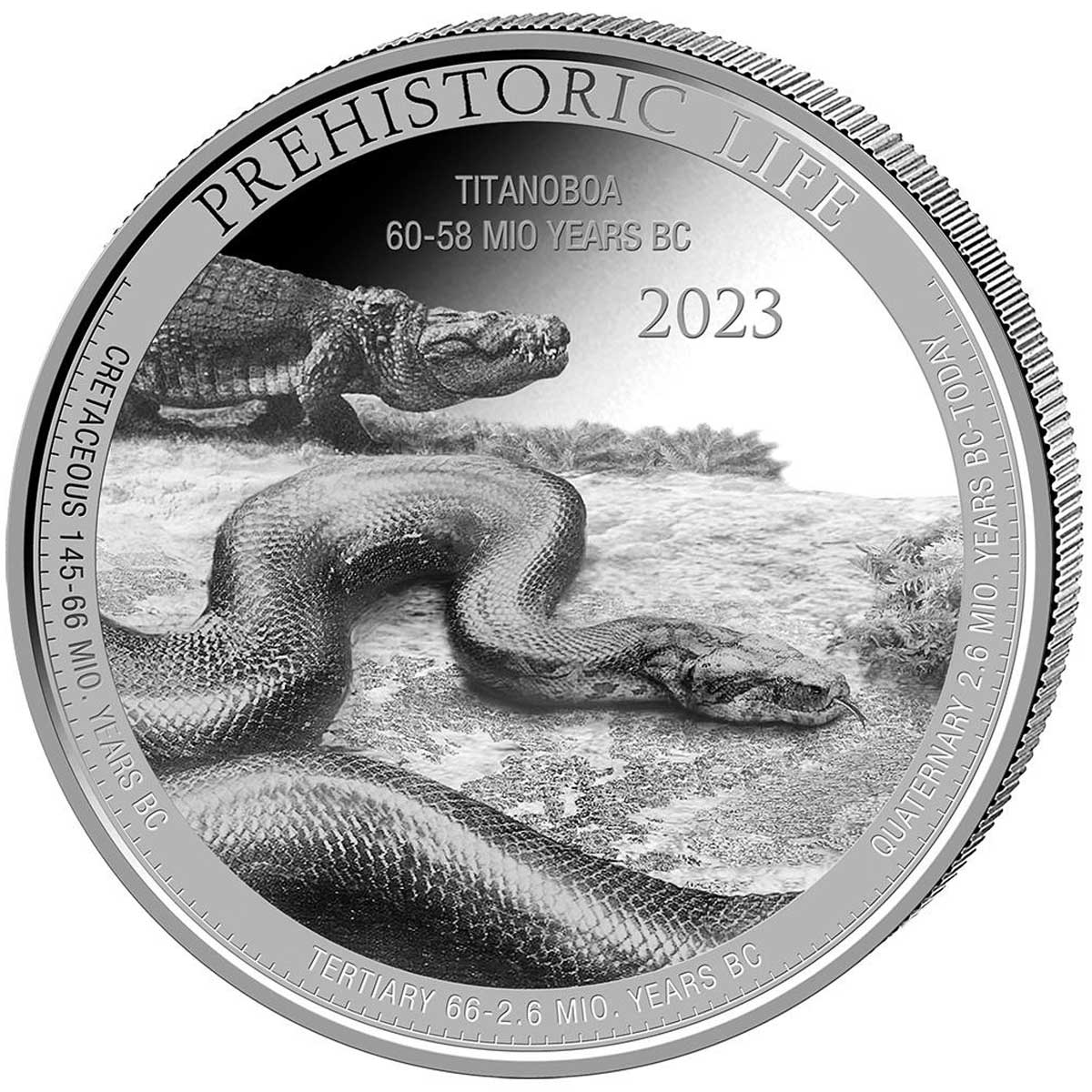

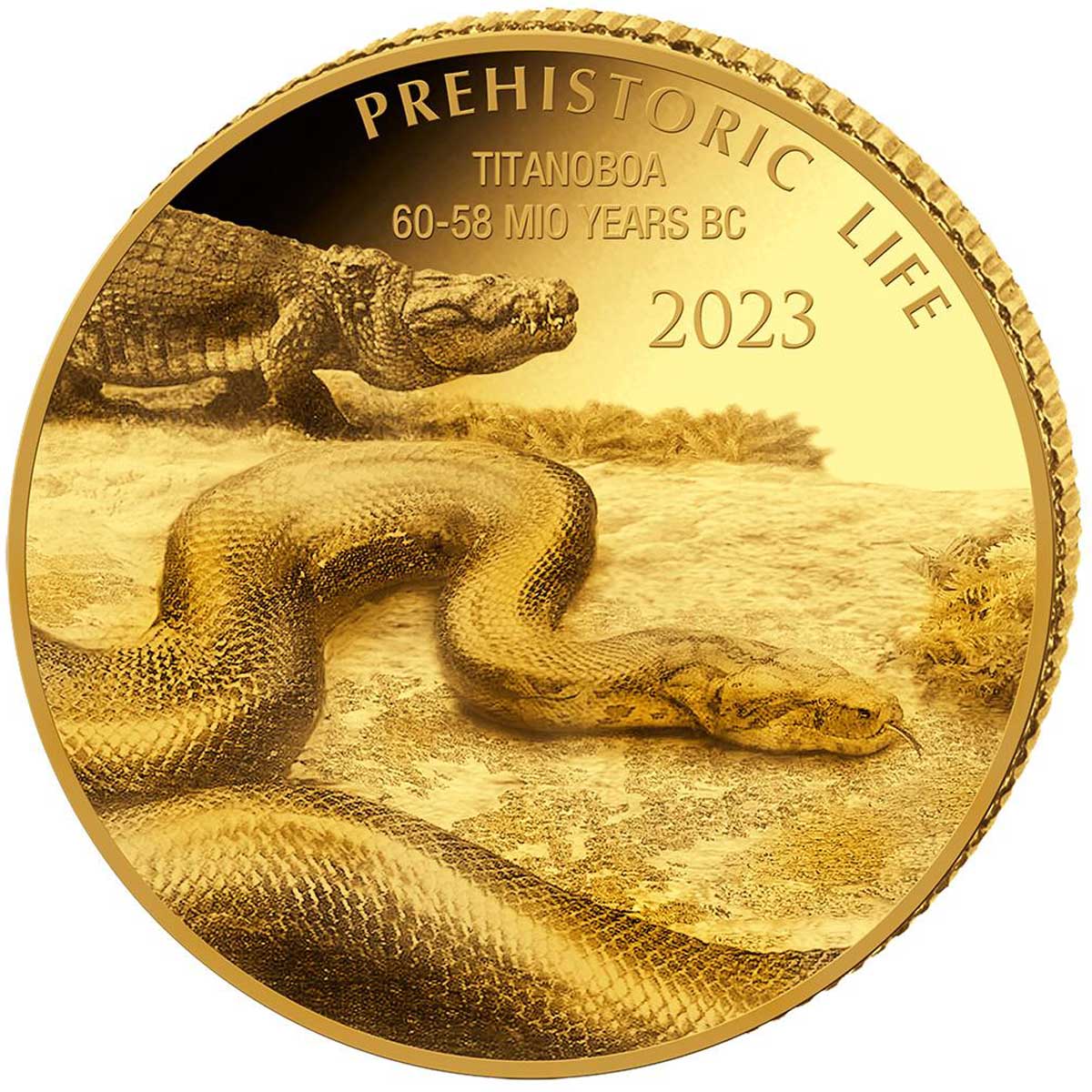
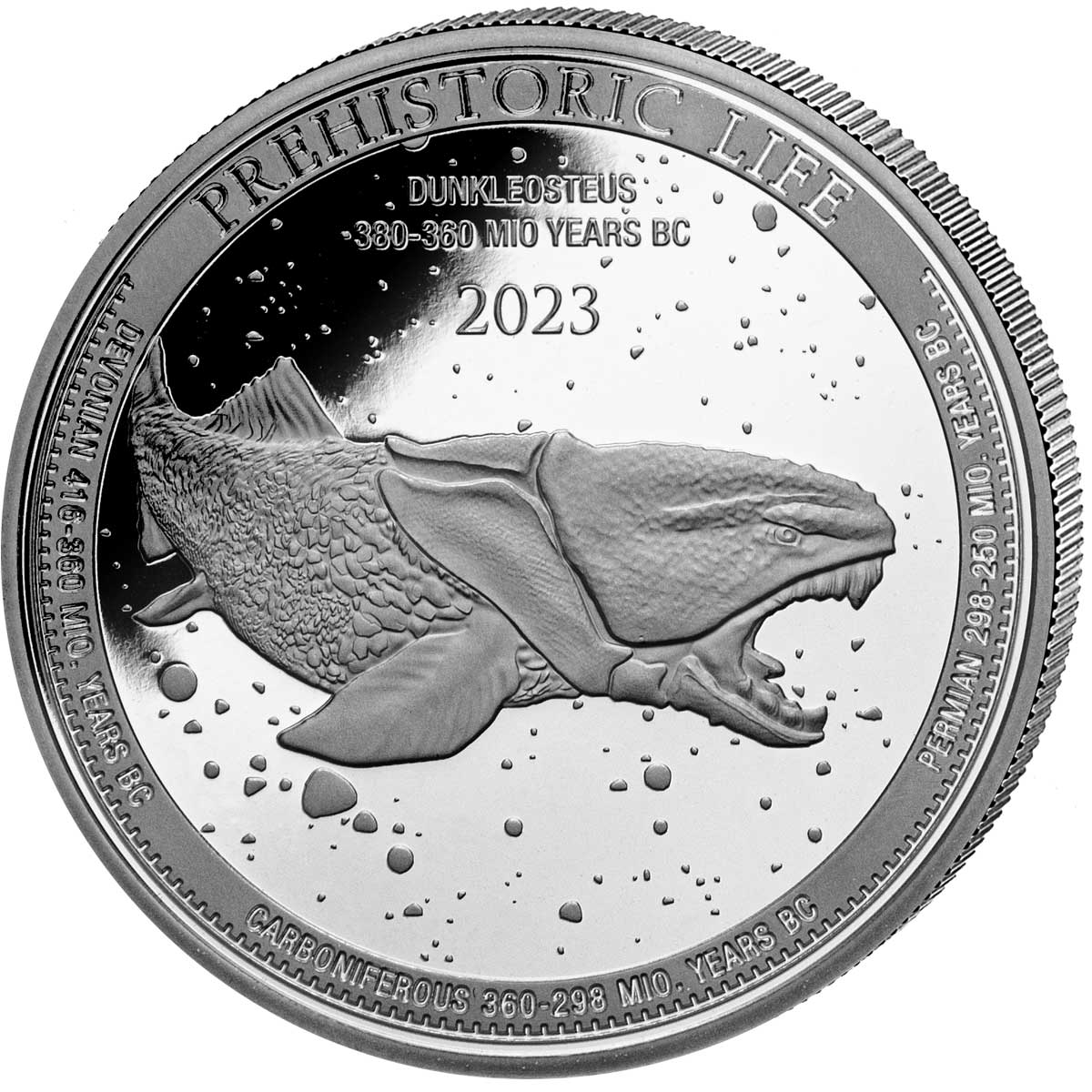


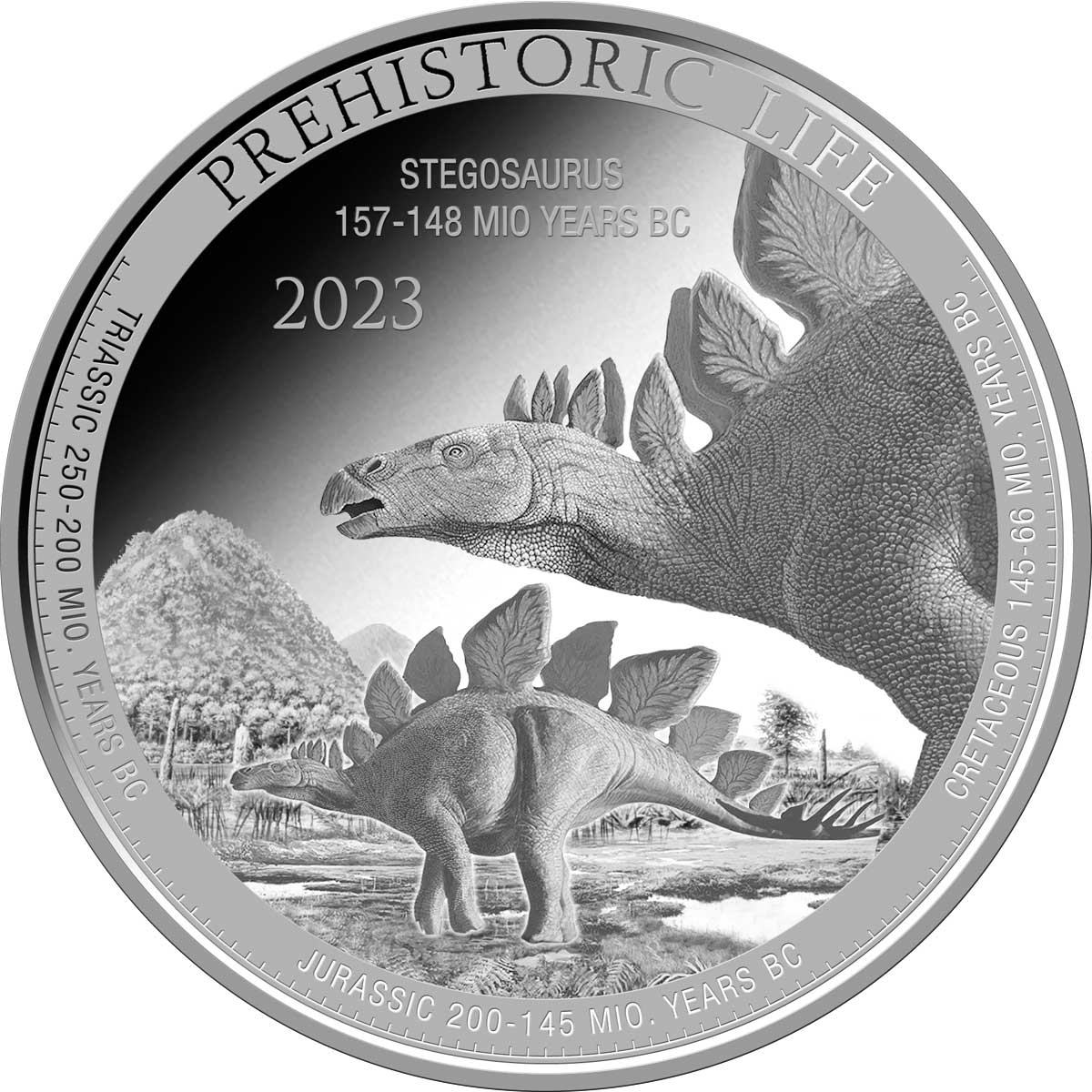
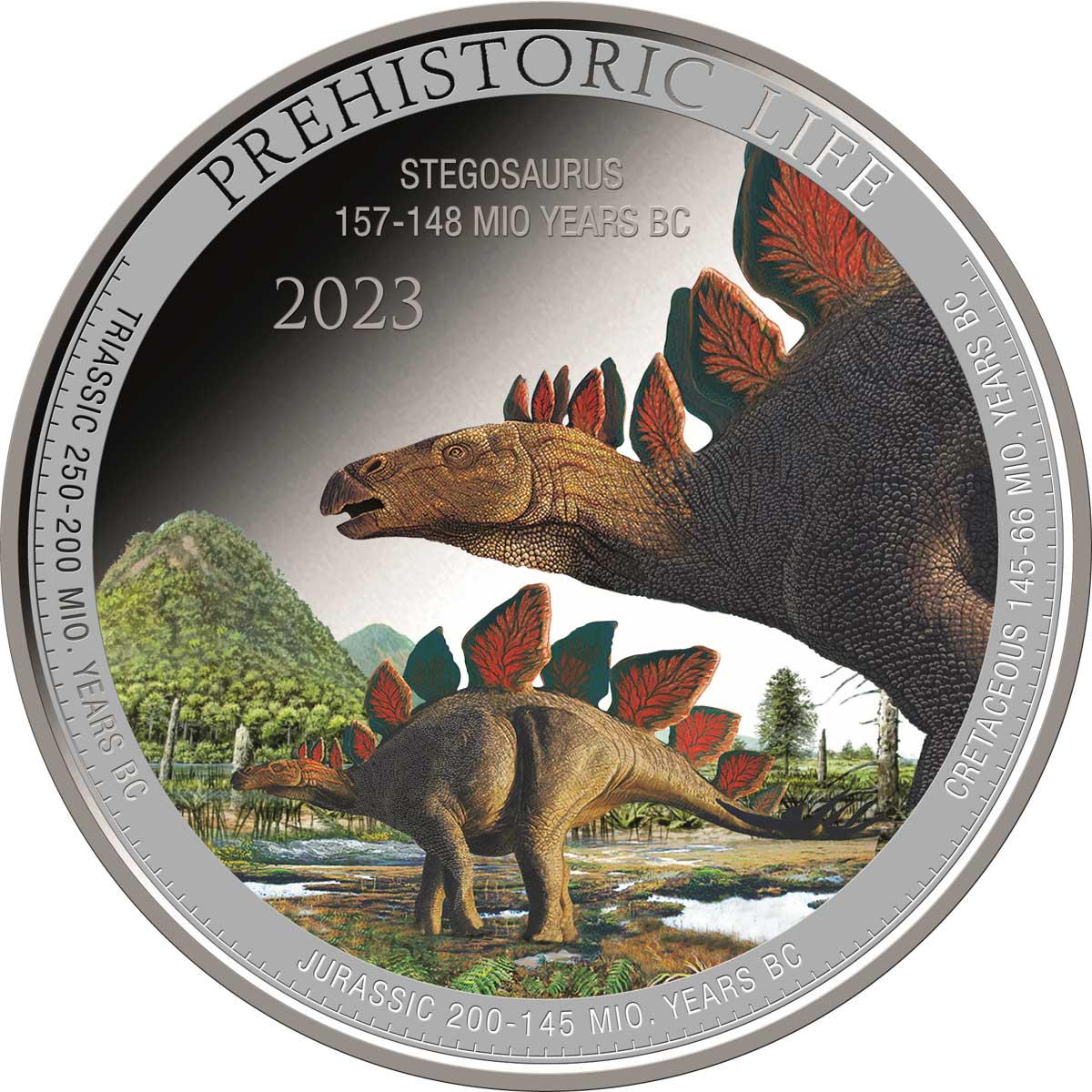



Leave A Comment